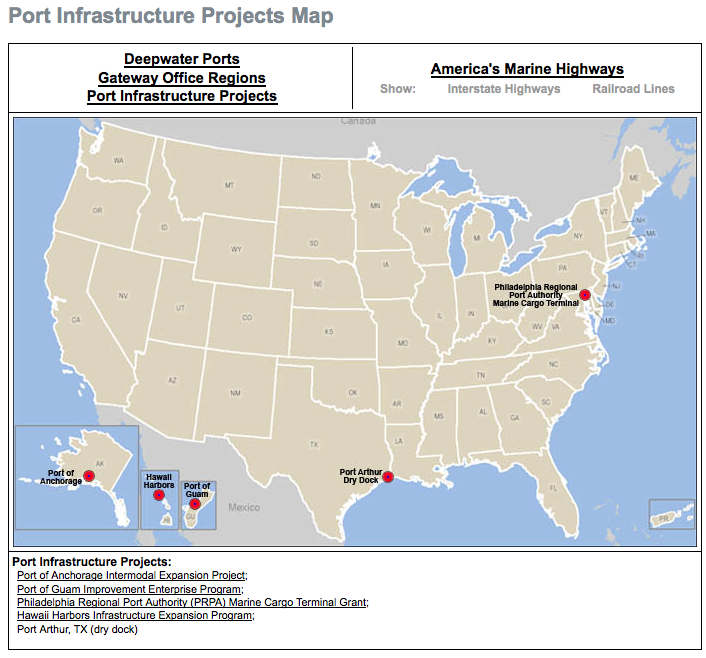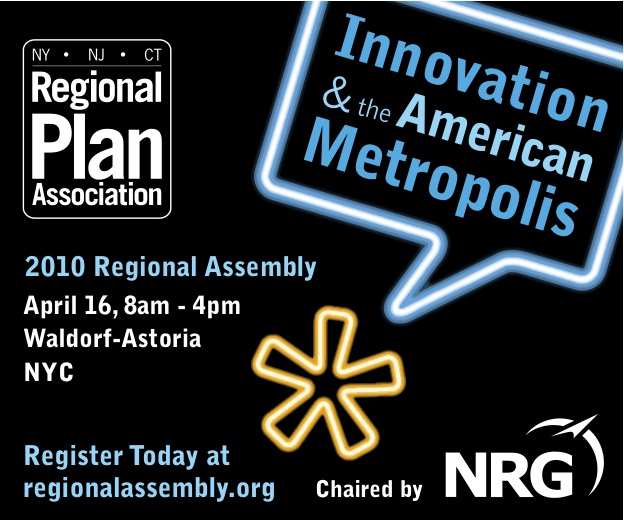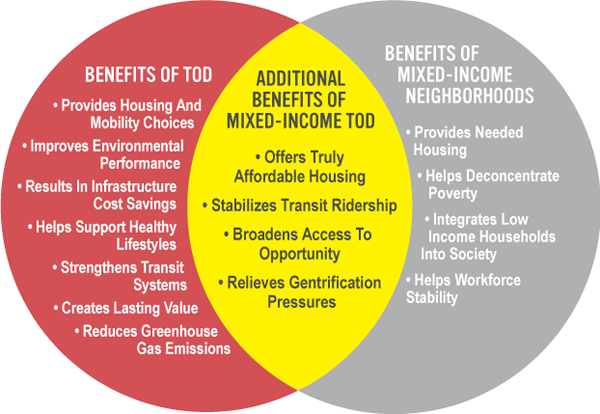Andy Lipkis, Founder and President of TreePeople, describes how this organization has pioneered an integrated approach to managing urban ecosystems as watersheds in the Los Angeles region.
View this complete post...Archive for the ‘Sustainability’ Category
Smart Green Infrastructure: How To Grow Sustainable Cities
Monday, April 12th, 2010Port Infrastructure Projects: Interactive Map
Monday, April 12th, 2010
According to a U.S. DOT Report on freight traffic, the number of trucks on our highways will more than double by 2035. Inland waterways, or “marine highways,” could reduce congestion by taking on some of the freight burden.
To make the port-and-waterway system more familiar, the U.S. Maritime Administration offers an interactive map, with information on current maritime infrastructure projects around the U.S. The map also shows inland waterways, interstate highways, railroads, and port locations around the country.
View this complete post...Regional Plan Association (RPA) addresses infra issues at Regional Assembly 2010 in NYC, April 16th
Wednesday, April 7th, 2010
REGIONAL ASSEMBLY 2010: INNOVATION & THE AMERICAN METROPOLIS
“The Regional Assembly is New York’s premier public policy event, bringing together several hundred top business, civic, philanthropic, media, and government leaders from across the metropolitan region and nation. Each year the Assembly focuses on a priority issue. This year, we examine how the innovative spirit and creativity of urban America can build and sustain a better future for our cities.”
Transit Oriented Development – A New Interactive Planning Tool
Monday, March 29th, 2010
The goal of the newly-released Mixed Income Transit Oriented Development Action Guide is to “help practitioners identify the most appropriate and effective planning tools for achieving MITOD in their transit station area, and ultimately to facilitate the development of mixed-income communities across the U.S.” It was developed by the Center for Transit Oriented Development (CTOD) along with the Federal Transit Administration and the U.S. Department of Housing and Urban Development.
View this complete post...Excerpts from The Brian Lehrer Show, with Gov. Rendell and Steve Anderson
Thursday, January 14th, 2010Wednesday, Jan. 13th
Steve Anderson, Managing Director, InfrastructureUSA.org, & Governor Edward G. Rendell, Building America’s Future, discussed infrastructure with WNYC radio host Brian Lehrer. Excerpts are available below, and you can listen to the entire program under “Infrastructure Matters” on WNYC.org.
View this complete post...Transportation Adaptation to Global Climate Change
Wednesday, December 23rd, 2009BIPARTISAN POLICY CENTER
Rising sea levels, greater weather variability, and more extreme weather events like hurricanes, permafrost thawing, and melting Arctic sea ice are just some of the important changes that will impact transportation networks and infrastructure. Coastal areas are particularly vulnerable. A large portion of the nation’s transportation infrastructure is in coastal zones: nearly half of the U.S. population lives within fifty miles of the coast, and many roads, rail lines, and airports were built at or near water’s edge to take advantage of available right-of-way and land. Increasingly intense storm activity and surges, exacerbated by rising sea levels, are putting an ever-increasing range of this coastal infrastructure at risk…
Guest on The Infra Blog: Robert D. Yaro, President, Regional Plan Association
Tuesday, November 24th, 2009
Robert D. Yaro is the President of Regional Plan Association, America’s oldest independent metropolitan policy, research and advocacy group. Mr. Yaro co-chairs the Empire State Alliance and the Friends of Moynihan Station, and is Vice President of the Forum of Urban Design. He serves on Mayor Bloomberg’s Sustainability Advisory Board, which helped prepare PlaNYC 2030, New York City’s new long-range sustainability plan. Since 2001 Mr. Yaro has been Professor of Practice in City and Regional Planning at the University of Pennsylvania. He also taught at Harvard University and the University of Massachusetts…
View this complete post...Climate Change in the United States: The Prohibitive Costs of Inaction
Thursday, November 12th, 2009UNION OF CONCERNED SCIENTISTS
“Recognizing the urgency of global warming, policy makers are beginning to pursue solutions to help us avoid the worst effects of climate change, while transitioning the nation to a clean energy economy. However, the debate over comprehensive climate and energy policy often focuses on the costs of climate action, rather than on the serious economic and environmental consequences if we fail to act. One study shows that if global warming emissions continue to grow unabated—a high-emissions scenario—the annual economic impact of more severe hurricanes, residential real-estate losses to sea-level rise, and growing water and energy costs could reach 1.4 percent of GDP by 2025, and 1.9 percent by 2100 (Ackerman and Stanton 2008).”
Guide to Operating and Maintaining EnergySmart Schools
Wednesday, November 11th, 2009U.S. DEPARTMENT OF ENERGY
“Through a commitment to high performance, school districts are discovering that smart energy choices can create lasting benefits for students, communities, and the environment. For example, an energy-efficient school district with 4,000 students can save as much as $160,000 a year in energy costs. Over 10 years, those savings can reach $1.6 million, translating into the ability to hire more teachers, purchase more textbooks and computers, or invest in additional highperformance facilities. Beyond these bottomline benefits, schools can better foster student health, decrease absenteeism, and serve as centers of community life.”
Follow InfrastructureUSA
CATEGORIES
- Accountability (219)
- Aging Infrastructure (747)
- Aviation (130)
- Biking (323)
- Bipartisan (271)
- Bridges (491)
- Broadband (57)
- Buses (160)
- Carbon Tax (22)
- Clean Air (182)
- Climate Change (199)
- Competitiveness (229)
- Congestion (327)
- Dams (77)
- Democrat (123)
- Drinking Water (191)
- Economic Stimulus (275)
- Employment (207)
- Energy (584)
- Environment (615)
- Equity (239)
- Funding (879)
- Global (205)
- Great American Infrastructure (33)
- Green (293)
- Guests on The Infra Blog (263)
- Hazardous Waste (27)
- High Speed Rail (224)
- Highway (783)
- Inland Waterways (204)
- Jobs (251)
- Land Use (97)
- LEED (28)
- Levees (42)
- Local (1,909)
- National (1,523)
- Policy (1,121)
- Pollution (215)
- Private Investment (213)
- Public Opinion (189)
- Public Parks & Recreation (194)
- Public Transportation (1,025)
- Racism (6)
- Rail (501)
- Recession (65)
- Recovery (218)
- Republican (109)
- Roads (1,118)
- Schools (79)
- Seaports (66)
- Smart Grid (98)
- Smart Growth (442)
- Solid Waste (26)
- Sustainability (763)
- Tax (112)
- Technology (395)
- Telecommunications (46)
- Transit (1,330)
- Urban Planning (977)
- Wastewater (180)
- Water Treatment (165)
Video, stills and tales. Share images of the Infra in your community that demands attention. Post your ideas about national Infra issues. Go ahead. Show Us Your Infra! Upload and instantly share your message.
Is the administration moving fast enough on Infra issues? Are Americans prepared to pay more taxes for repairs? Should job creation be the guiding determination? Vote now!
What do the experts think? This is where the nation's public policy organizations, trade associations and think tanks weigh in with analysis on Infra issues. Tell them what you think. Ask questions. Share a different view.
The Infra Blog offers cutting edge perspective on a broad spectrum of Infra topics. Frequent updates and provocative posts highlight hot button topics -- essential ingredients of a national Infra dialogue.
Dear Friends,
It is encouraging to finally see clear signs of federal action to support a comprehensive US infrastructure investment plan.
Now more than ever, our advocacy is needed to keep stakeholders informed and connected, and to hold politicians to their promises to finally fix our nation’s ailing infrastructure.
We have already engaged nearly 280,000 users, and hoping to add many more as interest continues to grow.
We require your support in order to rise to this occasion, to make the most of this opportunity. Please consider making a tax-deductible donation to InfrastructureUSA.org.
Steve Anderson
Managing Director
SteveAnderson@InfrastructureUSA.org
917-940-7125













 RSS Feed
RSS Feed